The Problem of Empty Houses in Bhutan: Causes and Impacts
VerifiedAdded on 2023/04/08
|37
|9489
|175
Report
AI Summary
This research paper examines the growing issue of empty houses in Bhutan, primarily caused by rural-urban migration. The study delves into the background of Bhutan, its cultural values, and the global trend of migration, highlighting the increasing abandonment of houses in rural areas. The paper aims to analyze the causes and impacts of this phenomenon, including its effects on the government, local communities, and the overall socio-economic landscape of Bhutan. The research employs a literature review approach, analyzing existing studies and media reports to understand the reasons behind migration, such as the search for better educational and career opportunities. The study further investigates the consequences of empty houses, including their impact on the government, society, and local communities. The research also provides recommendations to address the issue, with the aim of promoting sustainable development and minimizing the negative effects of rural-urban migration. The report also includes an introduction, literature review, case study, and conclusion and recommendations for further research.
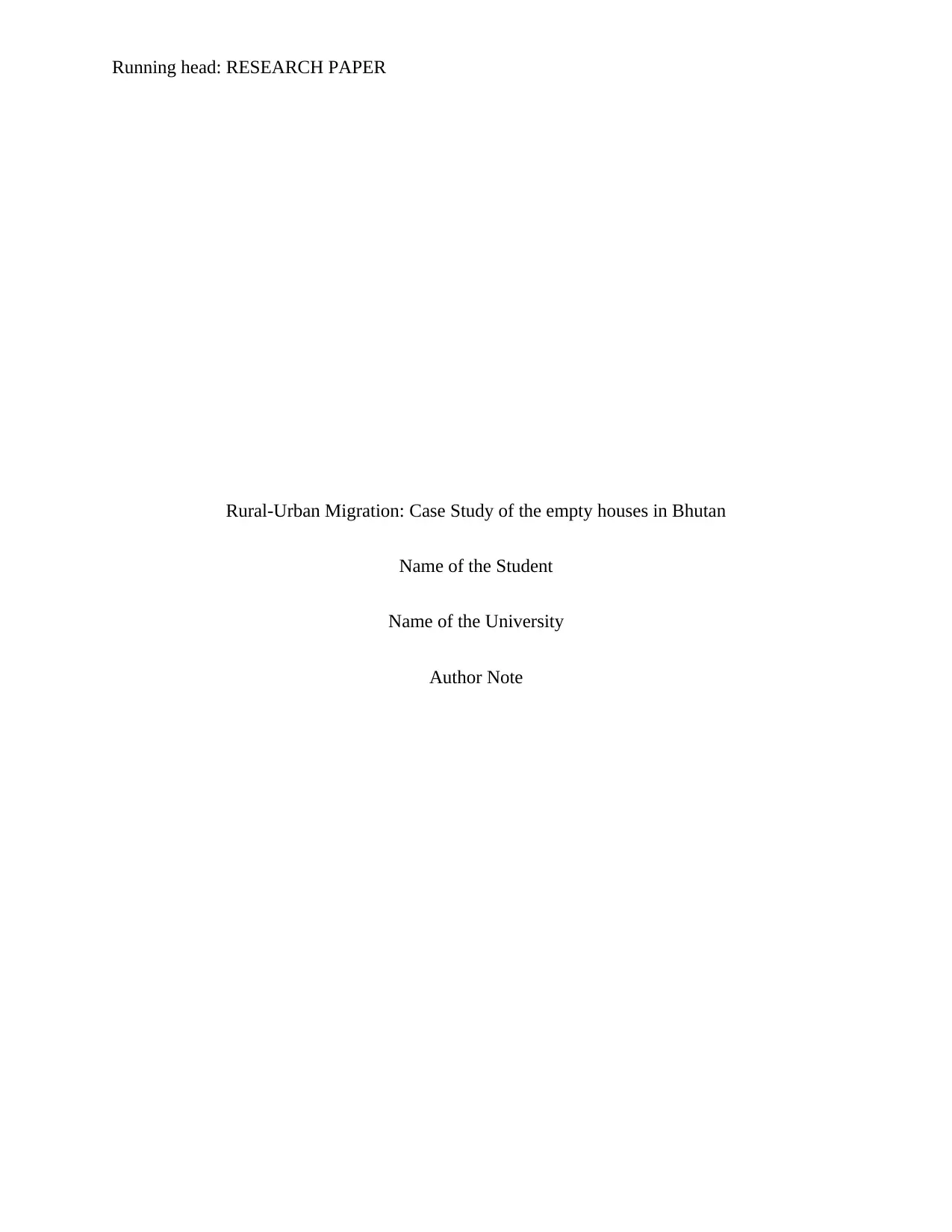
Running head: RESEARCH PAPER
Rural-Urban Migration: Case Study of the empty houses in Bhutan
Name of the Student
Name of the University
Author Note
Rural-Urban Migration: Case Study of the empty houses in Bhutan
Name of the Student
Name of the University
Author Note
Paraphrase This Document
Need a fresh take? Get an instant paraphrase of this document with our AI Paraphraser
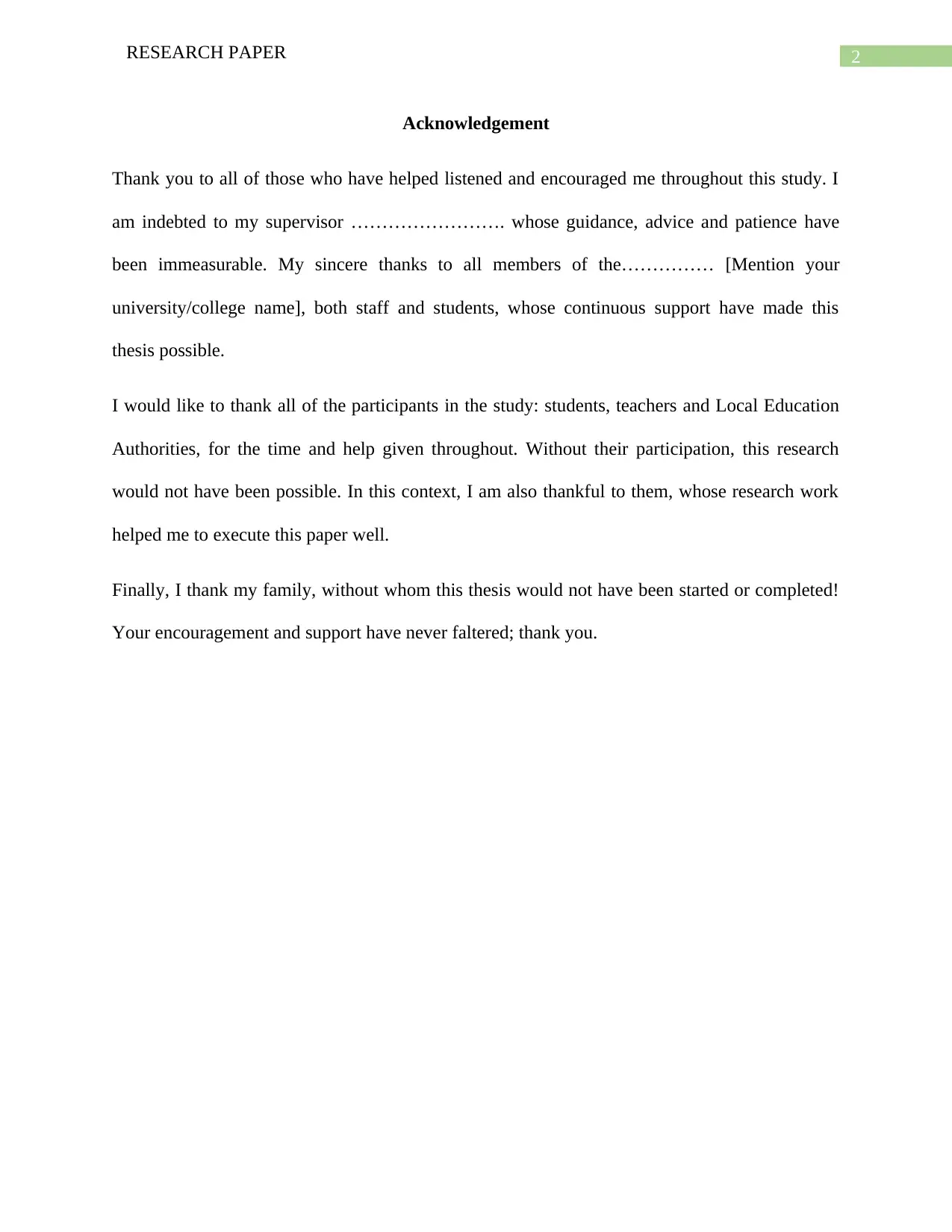
2RESEARCH PAPER
Acknowledgement
Thank you to all of those who have helped listened and encouraged me throughout this study. I
am indebted to my supervisor ……………………. whose guidance, advice and patience have
been immeasurable. My sincere thanks to all members of the…………… [Mention your
university/college name], both staff and students, whose continuous support have made this
thesis possible.
I would like to thank all of the participants in the study: students, teachers and Local Education
Authorities, for the time and help given throughout. Without their participation, this research
would not have been possible. In this context, I am also thankful to them, whose research work
helped me to execute this paper well.
Finally, I thank my family, without whom this thesis would not have been started or completed!
Your encouragement and support have never faltered; thank you.
Acknowledgement
Thank you to all of those who have helped listened and encouraged me throughout this study. I
am indebted to my supervisor ……………………. whose guidance, advice and patience have
been immeasurable. My sincere thanks to all members of the…………… [Mention your
university/college name], both staff and students, whose continuous support have made this
thesis possible.
I would like to thank all of the participants in the study: students, teachers and Local Education
Authorities, for the time and help given throughout. Without their participation, this research
would not have been possible. In this context, I am also thankful to them, whose research work
helped me to execute this paper well.
Finally, I thank my family, without whom this thesis would not have been started or completed!
Your encouragement and support have never faltered; thank you.
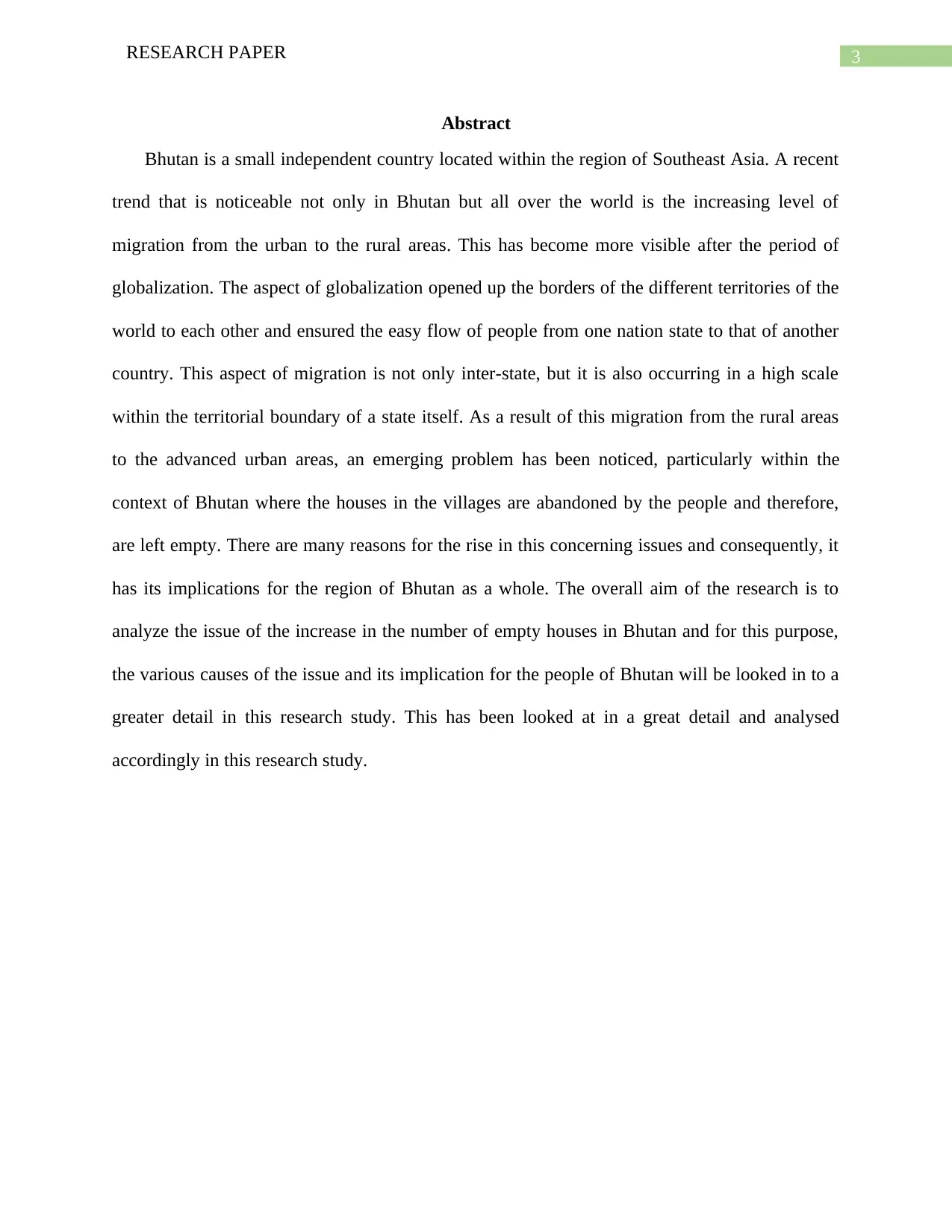
3RESEARCH PAPER
Abstract
Bhutan is a small independent country located within the region of Southeast Asia. A recent
trend that is noticeable not only in Bhutan but all over the world is the increasing level of
migration from the urban to the rural areas. This has become more visible after the period of
globalization. The aspect of globalization opened up the borders of the different territories of the
world to each other and ensured the easy flow of people from one nation state to that of another
country. This aspect of migration is not only inter-state, but it is also occurring in a high scale
within the territorial boundary of a state itself. As a result of this migration from the rural areas
to the advanced urban areas, an emerging problem has been noticed, particularly within the
context of Bhutan where the houses in the villages are abandoned by the people and therefore,
are left empty. There are many reasons for the rise in this concerning issues and consequently, it
has its implications for the region of Bhutan as a whole. The overall aim of the research is to
analyze the issue of the increase in the number of empty houses in Bhutan and for this purpose,
the various causes of the issue and its implication for the people of Bhutan will be looked in to a
greater detail in this research study. This has been looked at in a great detail and analysed
accordingly in this research study.
Abstract
Bhutan is a small independent country located within the region of Southeast Asia. A recent
trend that is noticeable not only in Bhutan but all over the world is the increasing level of
migration from the urban to the rural areas. This has become more visible after the period of
globalization. The aspect of globalization opened up the borders of the different territories of the
world to each other and ensured the easy flow of people from one nation state to that of another
country. This aspect of migration is not only inter-state, but it is also occurring in a high scale
within the territorial boundary of a state itself. As a result of this migration from the rural areas
to the advanced urban areas, an emerging problem has been noticed, particularly within the
context of Bhutan where the houses in the villages are abandoned by the people and therefore,
are left empty. There are many reasons for the rise in this concerning issues and consequently, it
has its implications for the region of Bhutan as a whole. The overall aim of the research is to
analyze the issue of the increase in the number of empty houses in Bhutan and for this purpose,
the various causes of the issue and its implication for the people of Bhutan will be looked in to a
greater detail in this research study. This has been looked at in a great detail and analysed
accordingly in this research study.
⊘ This is a preview!⊘
Do you want full access?
Subscribe today to unlock all pages.

Trusted by 1+ million students worldwide
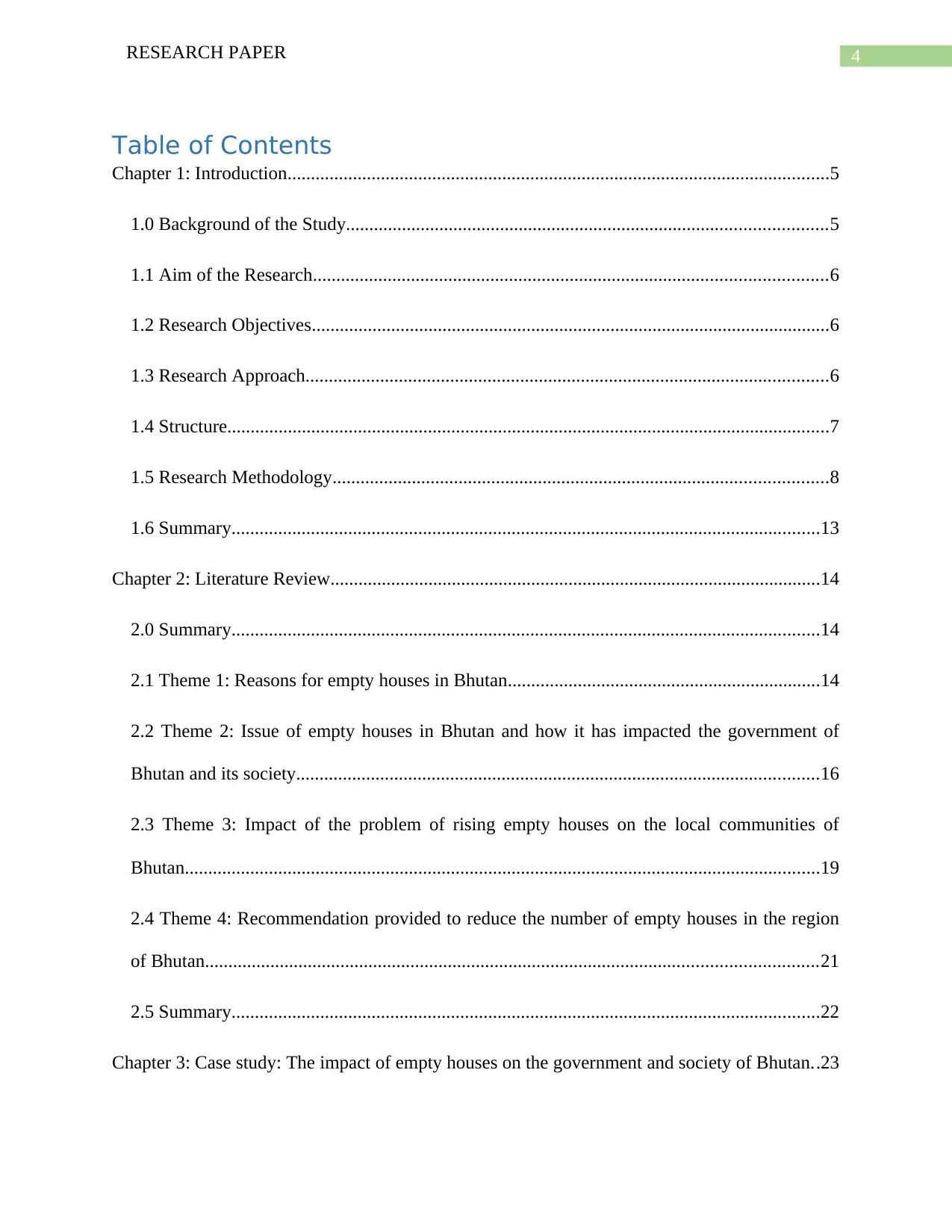
4RESEARCH PAPER
Table of Contents
Chapter 1: Introduction....................................................................................................................5
1.0 Background of the Study.......................................................................................................5
1.1 Aim of the Research..............................................................................................................6
1.2 Research Objectives...............................................................................................................6
1.3 Research Approach................................................................................................................6
1.4 Structure.................................................................................................................................7
1.5 Research Methodology..........................................................................................................8
1.6 Summary..............................................................................................................................13
Chapter 2: Literature Review.........................................................................................................14
2.0 Summary..............................................................................................................................14
2.1 Theme 1: Reasons for empty houses in Bhutan...................................................................14
2.2 Theme 2: Issue of empty houses in Bhutan and how it has impacted the government of
Bhutan and its society................................................................................................................16
2.3 Theme 3: Impact of the problem of rising empty houses on the local communities of
Bhutan........................................................................................................................................19
2.4 Theme 4: Recommendation provided to reduce the number of empty houses in the region
of Bhutan...................................................................................................................................21
2.5 Summary..............................................................................................................................22
Chapter 3: Case study: The impact of empty houses on the government and society of Bhutan..23
Table of Contents
Chapter 1: Introduction....................................................................................................................5
1.0 Background of the Study.......................................................................................................5
1.1 Aim of the Research..............................................................................................................6
1.2 Research Objectives...............................................................................................................6
1.3 Research Approach................................................................................................................6
1.4 Structure.................................................................................................................................7
1.5 Research Methodology..........................................................................................................8
1.6 Summary..............................................................................................................................13
Chapter 2: Literature Review.........................................................................................................14
2.0 Summary..............................................................................................................................14
2.1 Theme 1: Reasons for empty houses in Bhutan...................................................................14
2.2 Theme 2: Issue of empty houses in Bhutan and how it has impacted the government of
Bhutan and its society................................................................................................................16
2.3 Theme 3: Impact of the problem of rising empty houses on the local communities of
Bhutan........................................................................................................................................19
2.4 Theme 4: Recommendation provided to reduce the number of empty houses in the region
of Bhutan...................................................................................................................................21
2.5 Summary..............................................................................................................................22
Chapter 3: Case study: The impact of empty houses on the government and society of Bhutan..23
Paraphrase This Document
Need a fresh take? Get an instant paraphrase of this document with our AI Paraphraser
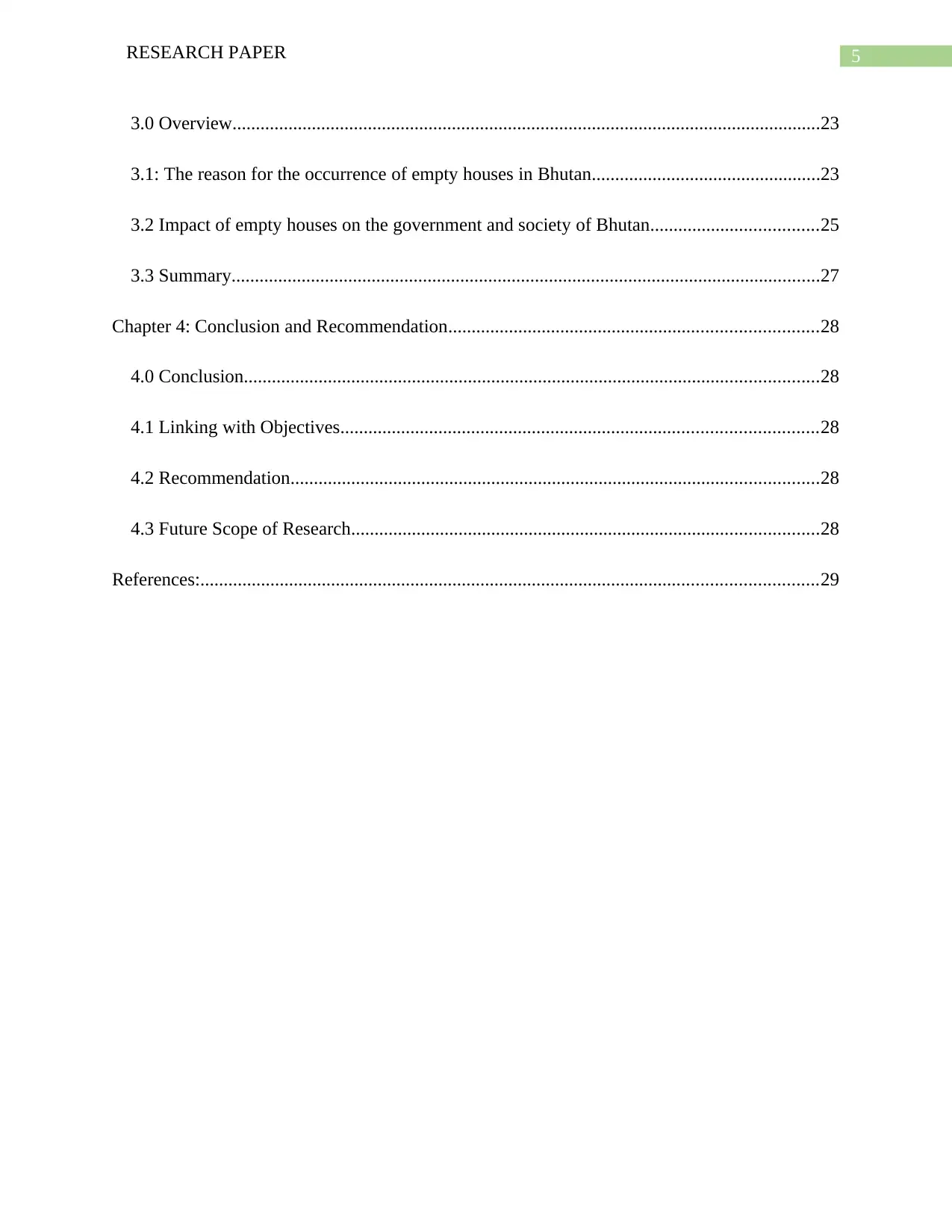
5RESEARCH PAPER
3.0 Overview..............................................................................................................................23
3.1: The reason for the occurrence of empty houses in Bhutan.................................................23
3.2 Impact of empty houses on the government and society of Bhutan....................................25
3.3 Summary..............................................................................................................................27
Chapter 4: Conclusion and Recommendation...............................................................................28
4.0 Conclusion...........................................................................................................................28
4.1 Linking with Objectives......................................................................................................28
4.2 Recommendation.................................................................................................................28
4.3 Future Scope of Research....................................................................................................28
References:....................................................................................................................................29
3.0 Overview..............................................................................................................................23
3.1: The reason for the occurrence of empty houses in Bhutan.................................................23
3.2 Impact of empty houses on the government and society of Bhutan....................................25
3.3 Summary..............................................................................................................................27
Chapter 4: Conclusion and Recommendation...............................................................................28
4.0 Conclusion...........................................................................................................................28
4.1 Linking with Objectives......................................................................................................28
4.2 Recommendation.................................................................................................................28
4.3 Future Scope of Research....................................................................................................28
References:....................................................................................................................................29
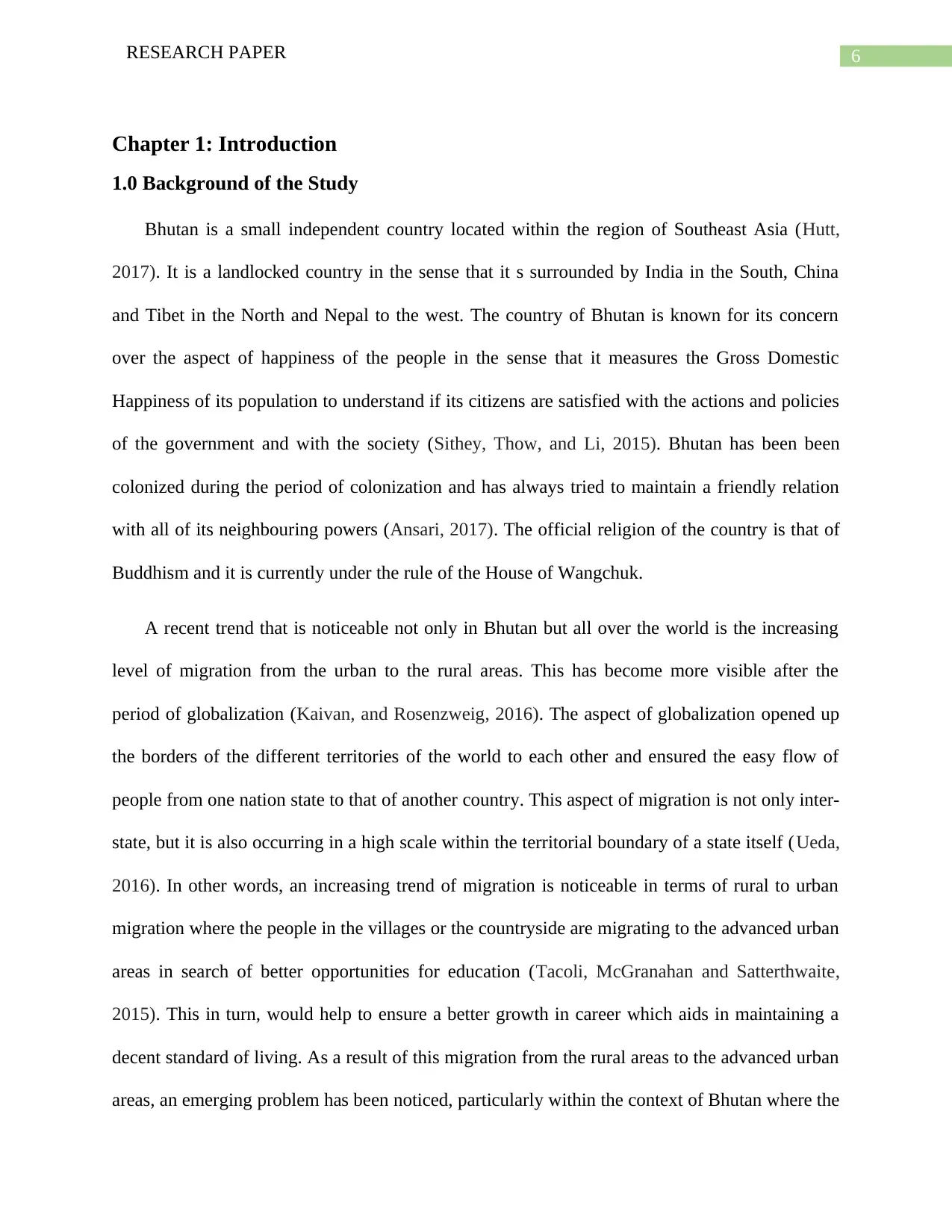
6RESEARCH PAPER
Chapter 1: Introduction
1.0 Background of the Study
Bhutan is a small independent country located within the region of Southeast Asia (Hutt,
2017). It is a landlocked country in the sense that it s surrounded by India in the South, China
and Tibet in the North and Nepal to the west. The country of Bhutan is known for its concern
over the aspect of happiness of the people in the sense that it measures the Gross Domestic
Happiness of its population to understand if its citizens are satisfied with the actions and policies
of the government and with the society (Sithey, Thow, and Li, 2015). Bhutan has been been
colonized during the period of colonization and has always tried to maintain a friendly relation
with all of its neighbouring powers (Ansari, 2017). The official religion of the country is that of
Buddhism and it is currently under the rule of the House of Wangchuk.
A recent trend that is noticeable not only in Bhutan but all over the world is the increasing
level of migration from the urban to the rural areas. This has become more visible after the
period of globalization (Kaivan, and Rosenzweig, 2016). The aspect of globalization opened up
the borders of the different territories of the world to each other and ensured the easy flow of
people from one nation state to that of another country. This aspect of migration is not only inter-
state, but it is also occurring in a high scale within the territorial boundary of a state itself (Ueda,
2016). In other words, an increasing trend of migration is noticeable in terms of rural to urban
migration where the people in the villages or the countryside are migrating to the advanced urban
areas in search of better opportunities for education (Tacoli, McGranahan and Satterthwaite,
2015). This in turn, would help to ensure a better growth in career which aids in maintaining a
decent standard of living. As a result of this migration from the rural areas to the advanced urban
areas, an emerging problem has been noticed, particularly within the context of Bhutan where the
Chapter 1: Introduction
1.0 Background of the Study
Bhutan is a small independent country located within the region of Southeast Asia (Hutt,
2017). It is a landlocked country in the sense that it s surrounded by India in the South, China
and Tibet in the North and Nepal to the west. The country of Bhutan is known for its concern
over the aspect of happiness of the people in the sense that it measures the Gross Domestic
Happiness of its population to understand if its citizens are satisfied with the actions and policies
of the government and with the society (Sithey, Thow, and Li, 2015). Bhutan has been been
colonized during the period of colonization and has always tried to maintain a friendly relation
with all of its neighbouring powers (Ansari, 2017). The official religion of the country is that of
Buddhism and it is currently under the rule of the House of Wangchuk.
A recent trend that is noticeable not only in Bhutan but all over the world is the increasing
level of migration from the urban to the rural areas. This has become more visible after the
period of globalization (Kaivan, and Rosenzweig, 2016). The aspect of globalization opened up
the borders of the different territories of the world to each other and ensured the easy flow of
people from one nation state to that of another country. This aspect of migration is not only inter-
state, but it is also occurring in a high scale within the territorial boundary of a state itself (Ueda,
2016). In other words, an increasing trend of migration is noticeable in terms of rural to urban
migration where the people in the villages or the countryside are migrating to the advanced urban
areas in search of better opportunities for education (Tacoli, McGranahan and Satterthwaite,
2015). This in turn, would help to ensure a better growth in career which aids in maintaining a
decent standard of living. As a result of this migration from the rural areas to the advanced urban
areas, an emerging problem has been noticed, particularly within the context of Bhutan where the
⊘ This is a preview!⊘
Do you want full access?
Subscribe today to unlock all pages.

Trusted by 1+ million students worldwide
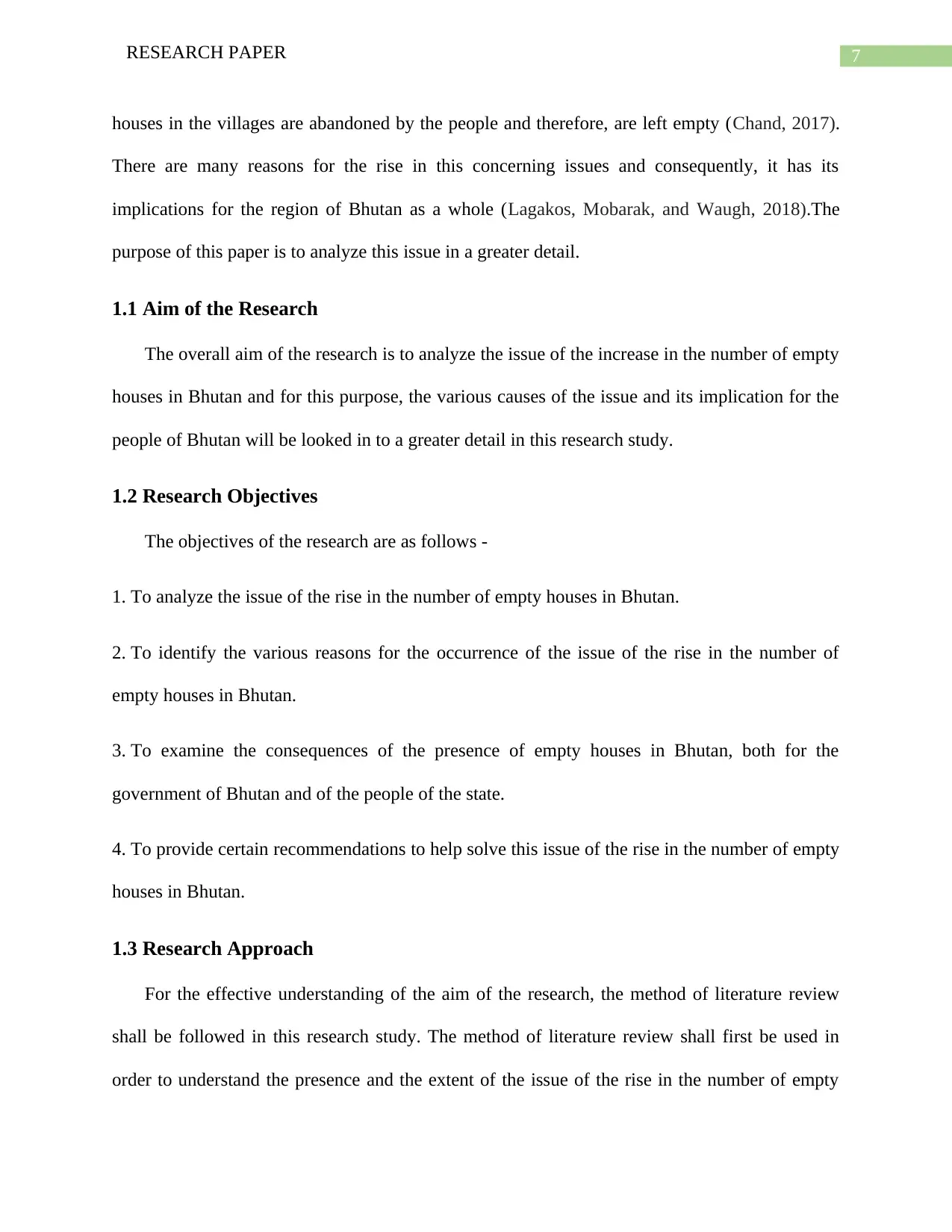
7RESEARCH PAPER
houses in the villages are abandoned by the people and therefore, are left empty (Chand, 2017).
There are many reasons for the rise in this concerning issues and consequently, it has its
implications for the region of Bhutan as a whole (Lagakos, Mobarak, and Waugh, 2018).The
purpose of this paper is to analyze this issue in a greater detail.
1.1 Aim of the Research
The overall aim of the research is to analyze the issue of the increase in the number of empty
houses in Bhutan and for this purpose, the various causes of the issue and its implication for the
people of Bhutan will be looked in to a greater detail in this research study.
1.2 Research Objectives
The objectives of the research are as follows -
1. To analyze the issue of the rise in the number of empty houses in Bhutan.
2. To identify the various reasons for the occurrence of the issue of the rise in the number of
empty houses in Bhutan.
3. To examine the consequences of the presence of empty houses in Bhutan, both for the
government of Bhutan and of the people of the state.
4. To provide certain recommendations to help solve this issue of the rise in the number of empty
houses in Bhutan.
1.3 Research Approach
For the effective understanding of the aim of the research, the method of literature review
shall be followed in this research study. The method of literature review shall first be used in
order to understand the presence and the extent of the issue of the rise in the number of empty
houses in the villages are abandoned by the people and therefore, are left empty (Chand, 2017).
There are many reasons for the rise in this concerning issues and consequently, it has its
implications for the region of Bhutan as a whole (Lagakos, Mobarak, and Waugh, 2018).The
purpose of this paper is to analyze this issue in a greater detail.
1.1 Aim of the Research
The overall aim of the research is to analyze the issue of the increase in the number of empty
houses in Bhutan and for this purpose, the various causes of the issue and its implication for the
people of Bhutan will be looked in to a greater detail in this research study.
1.2 Research Objectives
The objectives of the research are as follows -
1. To analyze the issue of the rise in the number of empty houses in Bhutan.
2. To identify the various reasons for the occurrence of the issue of the rise in the number of
empty houses in Bhutan.
3. To examine the consequences of the presence of empty houses in Bhutan, both for the
government of Bhutan and of the people of the state.
4. To provide certain recommendations to help solve this issue of the rise in the number of empty
houses in Bhutan.
1.3 Research Approach
For the effective understanding of the aim of the research, the method of literature review
shall be followed in this research study. The method of literature review shall first be used in
order to understand the presence and the extent of the issue of the rise in the number of empty
Paraphrase This Document
Need a fresh take? Get an instant paraphrase of this document with our AI Paraphraser
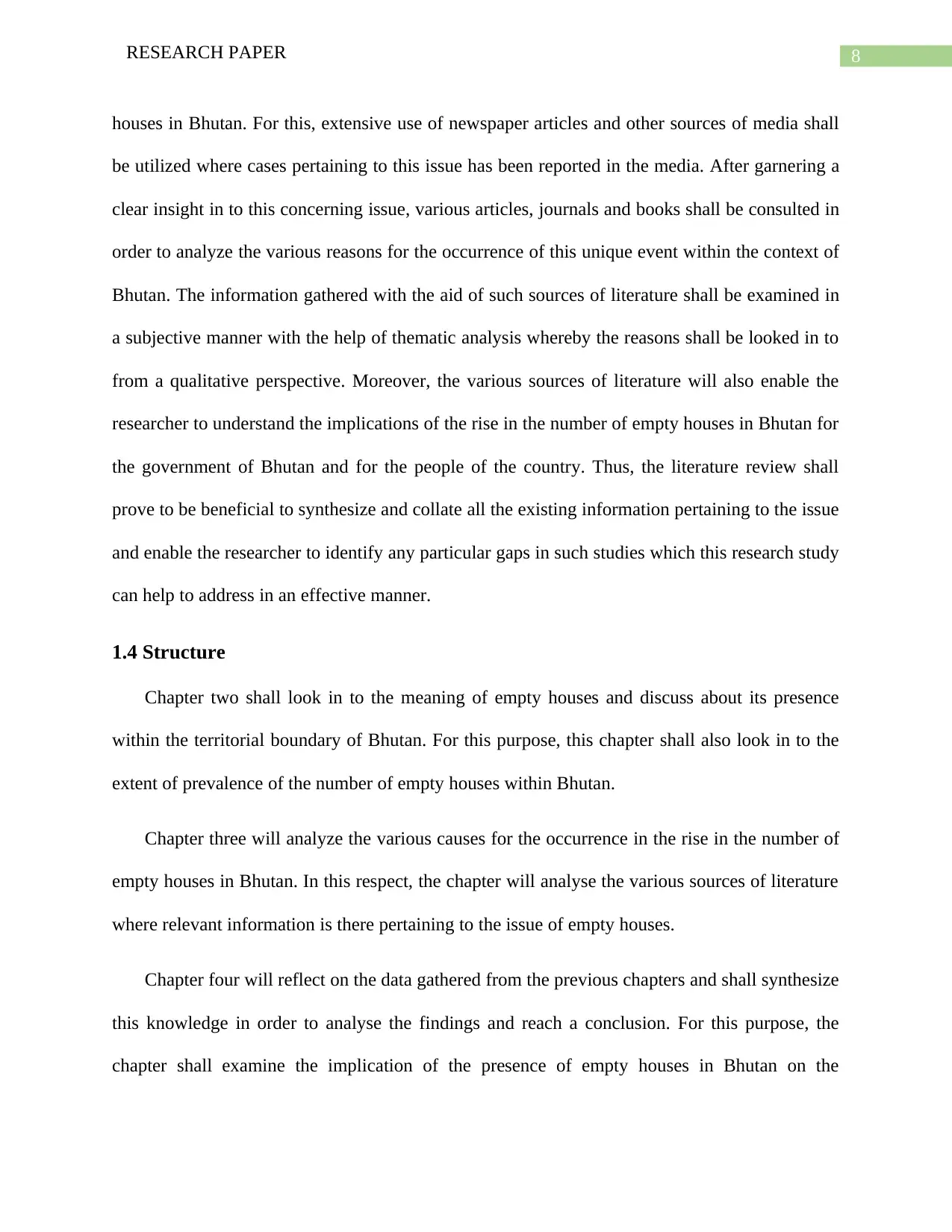
8RESEARCH PAPER
houses in Bhutan. For this, extensive use of newspaper articles and other sources of media shall
be utilized where cases pertaining to this issue has been reported in the media. After garnering a
clear insight in to this concerning issue, various articles, journals and books shall be consulted in
order to analyze the various reasons for the occurrence of this unique event within the context of
Bhutan. The information gathered with the aid of such sources of literature shall be examined in
a subjective manner with the help of thematic analysis whereby the reasons shall be looked in to
from a qualitative perspective. Moreover, the various sources of literature will also enable the
researcher to understand the implications of the rise in the number of empty houses in Bhutan for
the government of Bhutan and for the people of the country. Thus, the literature review shall
prove to be beneficial to synthesize and collate all the existing information pertaining to the issue
and enable the researcher to identify any particular gaps in such studies which this research study
can help to address in an effective manner.
1.4 Structure
Chapter two shall look in to the meaning of empty houses and discuss about its presence
within the territorial boundary of Bhutan. For this purpose, this chapter shall also look in to the
extent of prevalence of the number of empty houses within Bhutan.
Chapter three will analyze the various causes for the occurrence in the rise in the number of
empty houses in Bhutan. In this respect, the chapter will analyse the various sources of literature
where relevant information is there pertaining to the issue of empty houses.
Chapter four will reflect on the data gathered from the previous chapters and shall synthesize
this knowledge in order to analyse the findings and reach a conclusion. For this purpose, the
chapter shall examine the implication of the presence of empty houses in Bhutan on the
houses in Bhutan. For this, extensive use of newspaper articles and other sources of media shall
be utilized where cases pertaining to this issue has been reported in the media. After garnering a
clear insight in to this concerning issue, various articles, journals and books shall be consulted in
order to analyze the various reasons for the occurrence of this unique event within the context of
Bhutan. The information gathered with the aid of such sources of literature shall be examined in
a subjective manner with the help of thematic analysis whereby the reasons shall be looked in to
from a qualitative perspective. Moreover, the various sources of literature will also enable the
researcher to understand the implications of the rise in the number of empty houses in Bhutan for
the government of Bhutan and for the people of the country. Thus, the literature review shall
prove to be beneficial to synthesize and collate all the existing information pertaining to the issue
and enable the researcher to identify any particular gaps in such studies which this research study
can help to address in an effective manner.
1.4 Structure
Chapter two shall look in to the meaning of empty houses and discuss about its presence
within the territorial boundary of Bhutan. For this purpose, this chapter shall also look in to the
extent of prevalence of the number of empty houses within Bhutan.
Chapter three will analyze the various causes for the occurrence in the rise in the number of
empty houses in Bhutan. In this respect, the chapter will analyse the various sources of literature
where relevant information is there pertaining to the issue of empty houses.
Chapter four will reflect on the data gathered from the previous chapters and shall synthesize
this knowledge in order to analyse the findings and reach a conclusion. For this purpose, the
chapter shall examine the implication of the presence of empty houses in Bhutan on the
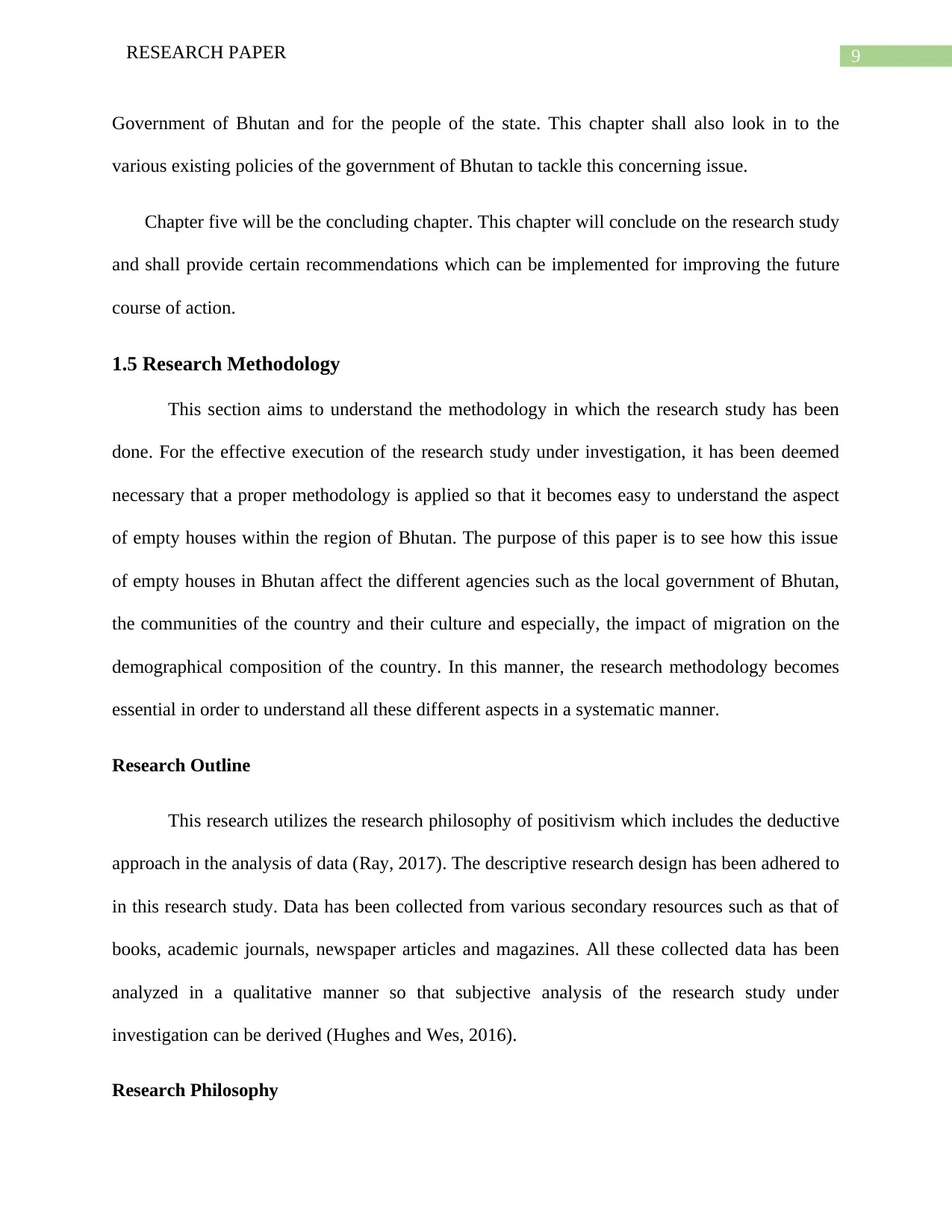
9RESEARCH PAPER
Government of Bhutan and for the people of the state. This chapter shall also look in to the
various existing policies of the government of Bhutan to tackle this concerning issue.
Chapter five will be the concluding chapter. This chapter will conclude on the research study
and shall provide certain recommendations which can be implemented for improving the future
course of action.
1.5 Research Methodology
This section aims to understand the methodology in which the research study has been
done. For the effective execution of the research study under investigation, it has been deemed
necessary that a proper methodology is applied so that it becomes easy to understand the aspect
of empty houses within the region of Bhutan. The purpose of this paper is to see how this issue
of empty houses in Bhutan affect the different agencies such as the local government of Bhutan,
the communities of the country and their culture and especially, the impact of migration on the
demographical composition of the country. In this manner, the research methodology becomes
essential in order to understand all these different aspects in a systematic manner.
Research Outline
This research utilizes the research philosophy of positivism which includes the deductive
approach in the analysis of data (Ray, 2017). The descriptive research design has been adhered to
in this research study. Data has been collected from various secondary resources such as that of
books, academic journals, newspaper articles and magazines. All these collected data has been
analyzed in a qualitative manner so that subjective analysis of the research study under
investigation can be derived (Hughes and Wes, 2016).
Research Philosophy
Government of Bhutan and for the people of the state. This chapter shall also look in to the
various existing policies of the government of Bhutan to tackle this concerning issue.
Chapter five will be the concluding chapter. This chapter will conclude on the research study
and shall provide certain recommendations which can be implemented for improving the future
course of action.
1.5 Research Methodology
This section aims to understand the methodology in which the research study has been
done. For the effective execution of the research study under investigation, it has been deemed
necessary that a proper methodology is applied so that it becomes easy to understand the aspect
of empty houses within the region of Bhutan. The purpose of this paper is to see how this issue
of empty houses in Bhutan affect the different agencies such as the local government of Bhutan,
the communities of the country and their culture and especially, the impact of migration on the
demographical composition of the country. In this manner, the research methodology becomes
essential in order to understand all these different aspects in a systematic manner.
Research Outline
This research utilizes the research philosophy of positivism which includes the deductive
approach in the analysis of data (Ray, 2017). The descriptive research design has been adhered to
in this research study. Data has been collected from various secondary resources such as that of
books, academic journals, newspaper articles and magazines. All these collected data has been
analyzed in a qualitative manner so that subjective analysis of the research study under
investigation can be derived (Hughes and Wes, 2016).
Research Philosophy
⊘ This is a preview!⊘
Do you want full access?
Subscribe today to unlock all pages.

Trusted by 1+ million students worldwide
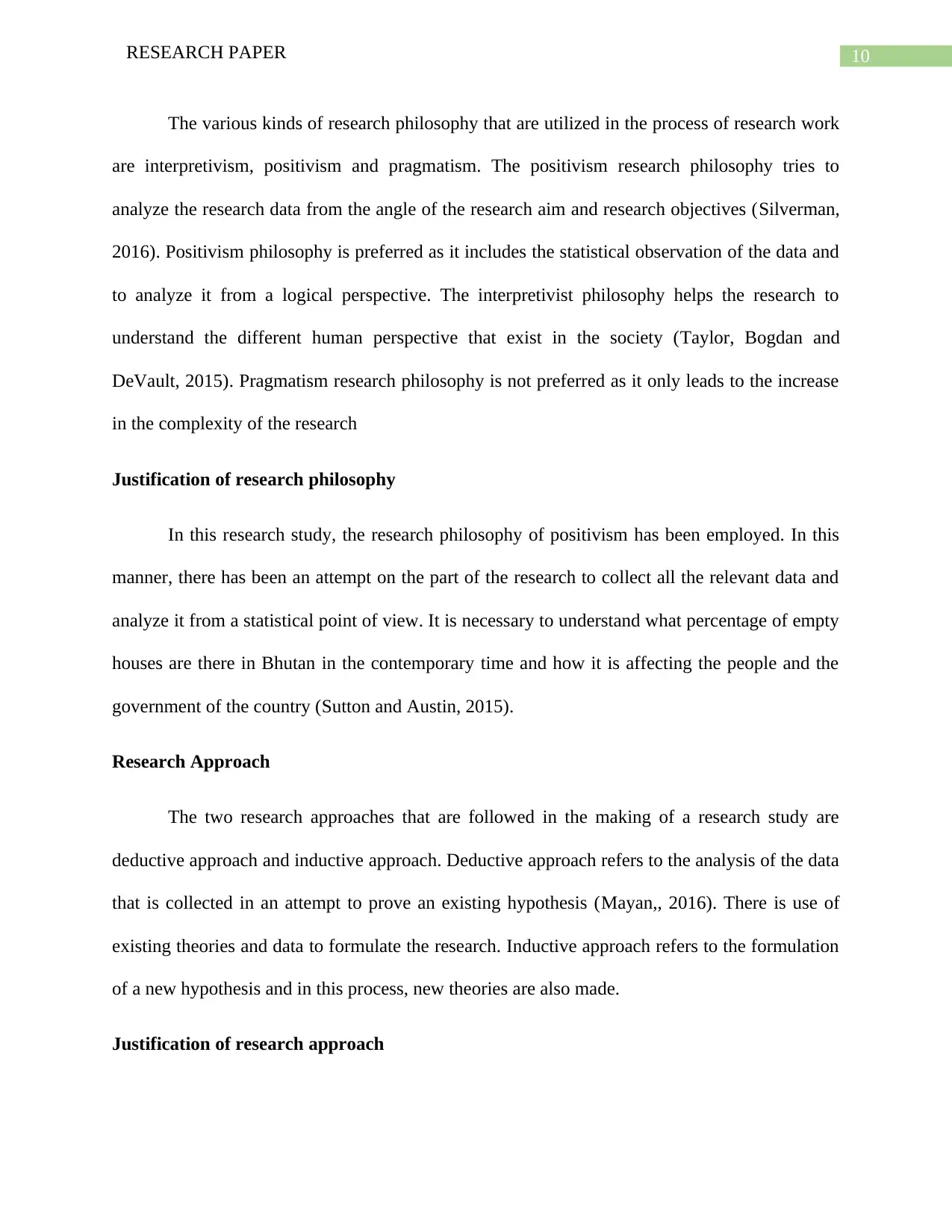
10RESEARCH PAPER
The various kinds of research philosophy that are utilized in the process of research work
are interpretivism, positivism and pragmatism. The positivism research philosophy tries to
analyze the research data from the angle of the research aim and research objectives (Silverman,
2016). Positivism philosophy is preferred as it includes the statistical observation of the data and
to analyze it from a logical perspective. The interpretivist philosophy helps the research to
understand the different human perspective that exist in the society (Taylor, Bogdan and
DeVault, 2015). Pragmatism research philosophy is not preferred as it only leads to the increase
in the complexity of the research
Justification of research philosophy
In this research study, the research philosophy of positivism has been employed. In this
manner, there has been an attempt on the part of the research to collect all the relevant data and
analyze it from a statistical point of view. It is necessary to understand what percentage of empty
houses are there in Bhutan in the contemporary time and how it is affecting the people and the
government of the country (Sutton and Austin, 2015).
Research Approach
The two research approaches that are followed in the making of a research study are
deductive approach and inductive approach. Deductive approach refers to the analysis of the data
that is collected in an attempt to prove an existing hypothesis (Mayan,, 2016). There is use of
existing theories and data to formulate the research. Inductive approach refers to the formulation
of a new hypothesis and in this process, new theories are also made.
Justification of research approach
The various kinds of research philosophy that are utilized in the process of research work
are interpretivism, positivism and pragmatism. The positivism research philosophy tries to
analyze the research data from the angle of the research aim and research objectives (Silverman,
2016). Positivism philosophy is preferred as it includes the statistical observation of the data and
to analyze it from a logical perspective. The interpretivist philosophy helps the research to
understand the different human perspective that exist in the society (Taylor, Bogdan and
DeVault, 2015). Pragmatism research philosophy is not preferred as it only leads to the increase
in the complexity of the research
Justification of research philosophy
In this research study, the research philosophy of positivism has been employed. In this
manner, there has been an attempt on the part of the research to collect all the relevant data and
analyze it from a statistical point of view. It is necessary to understand what percentage of empty
houses are there in Bhutan in the contemporary time and how it is affecting the people and the
government of the country (Sutton and Austin, 2015).
Research Approach
The two research approaches that are followed in the making of a research study are
deductive approach and inductive approach. Deductive approach refers to the analysis of the data
that is collected in an attempt to prove an existing hypothesis (Mayan,, 2016). There is use of
existing theories and data to formulate the research. Inductive approach refers to the formulation
of a new hypothesis and in this process, new theories are also made.
Justification of research approach
Paraphrase This Document
Need a fresh take? Get an instant paraphrase of this document with our AI Paraphraser
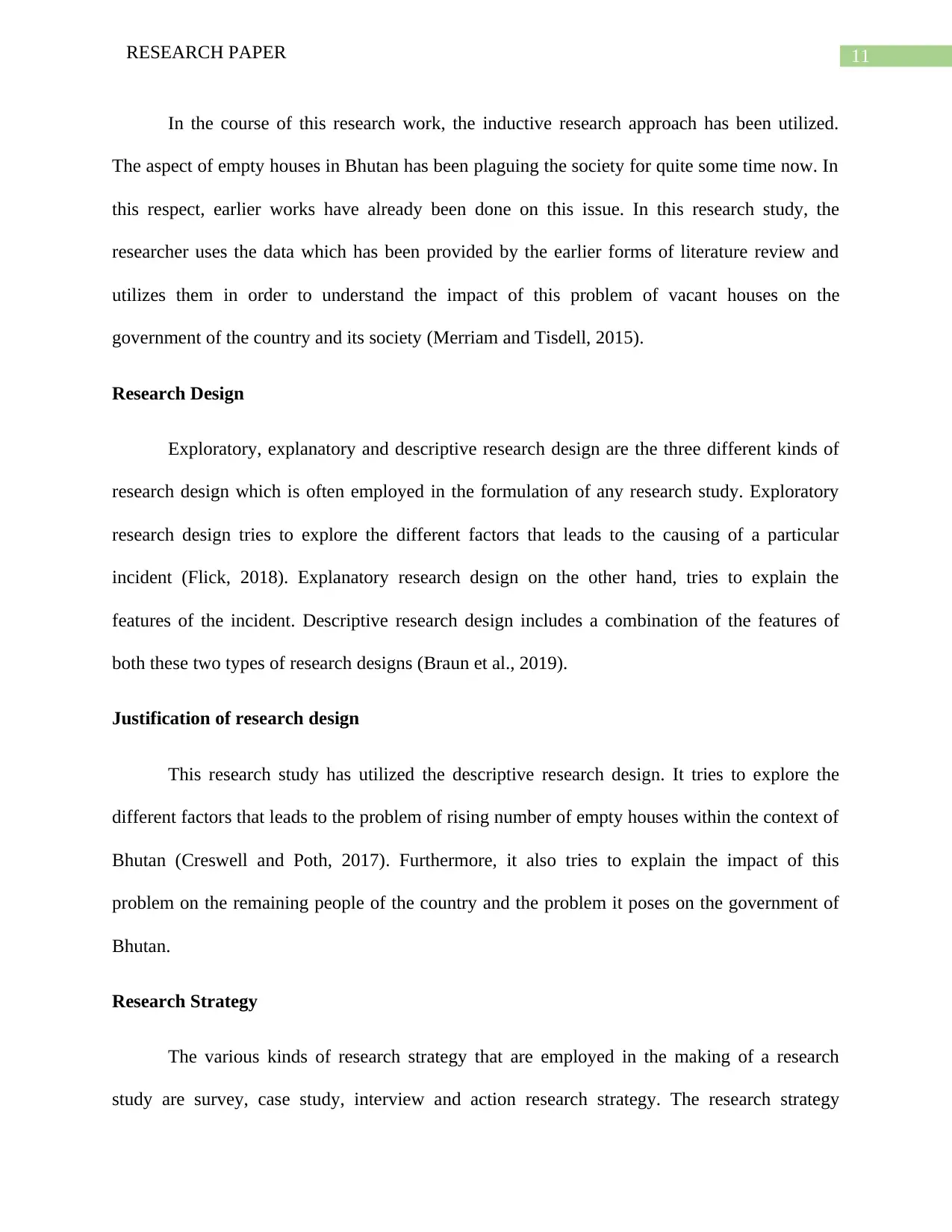
11RESEARCH PAPER
In the course of this research work, the inductive research approach has been utilized.
The aspect of empty houses in Bhutan has been plaguing the society for quite some time now. In
this respect, earlier works have already been done on this issue. In this research study, the
researcher uses the data which has been provided by the earlier forms of literature review and
utilizes them in order to understand the impact of this problem of vacant houses on the
government of the country and its society (Merriam and Tisdell, 2015).
Research Design
Exploratory, explanatory and descriptive research design are the three different kinds of
research design which is often employed in the formulation of any research study. Exploratory
research design tries to explore the different factors that leads to the causing of a particular
incident (Flick, 2018). Explanatory research design on the other hand, tries to explain the
features of the incident. Descriptive research design includes a combination of the features of
both these two types of research designs (Braun et al., 2019).
Justification of research design
This research study has utilized the descriptive research design. It tries to explore the
different factors that leads to the problem of rising number of empty houses within the context of
Bhutan (Creswell and Poth, 2017). Furthermore, it also tries to explain the impact of this
problem on the remaining people of the country and the problem it poses on the government of
Bhutan.
Research Strategy
The various kinds of research strategy that are employed in the making of a research
study are survey, case study, interview and action research strategy. The research strategy
In the course of this research work, the inductive research approach has been utilized.
The aspect of empty houses in Bhutan has been plaguing the society for quite some time now. In
this respect, earlier works have already been done on this issue. In this research study, the
researcher uses the data which has been provided by the earlier forms of literature review and
utilizes them in order to understand the impact of this problem of vacant houses on the
government of the country and its society (Merriam and Tisdell, 2015).
Research Design
Exploratory, explanatory and descriptive research design are the three different kinds of
research design which is often employed in the formulation of any research study. Exploratory
research design tries to explore the different factors that leads to the causing of a particular
incident (Flick, 2018). Explanatory research design on the other hand, tries to explain the
features of the incident. Descriptive research design includes a combination of the features of
both these two types of research designs (Braun et al., 2019).
Justification of research design
This research study has utilized the descriptive research design. It tries to explore the
different factors that leads to the problem of rising number of empty houses within the context of
Bhutan (Creswell and Poth, 2017). Furthermore, it also tries to explain the impact of this
problem on the remaining people of the country and the problem it poses on the government of
Bhutan.
Research Strategy
The various kinds of research strategy that are employed in the making of a research
study are survey, case study, interview and action research strategy. The research strategy
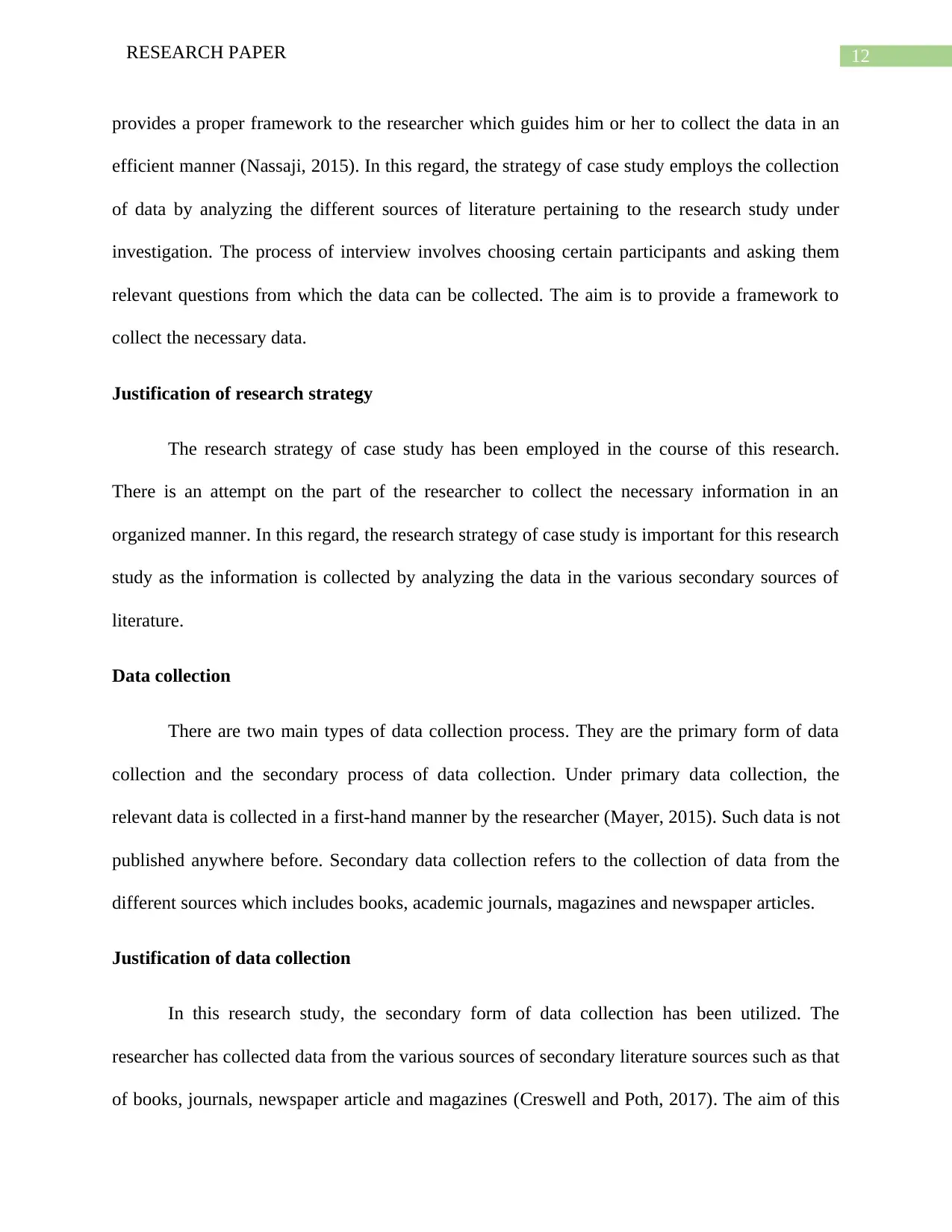
12RESEARCH PAPER
provides a proper framework to the researcher which guides him or her to collect the data in an
efficient manner (Nassaji, 2015). In this regard, the strategy of case study employs the collection
of data by analyzing the different sources of literature pertaining to the research study under
investigation. The process of interview involves choosing certain participants and asking them
relevant questions from which the data can be collected. The aim is to provide a framework to
collect the necessary data.
Justification of research strategy
The research strategy of case study has been employed in the course of this research.
There is an attempt on the part of the researcher to collect the necessary information in an
organized manner. In this regard, the research strategy of case study is important for this research
study as the information is collected by analyzing the data in the various secondary sources of
literature.
Data collection
There are two main types of data collection process. They are the primary form of data
collection and the secondary process of data collection. Under primary data collection, the
relevant data is collected in a first-hand manner by the researcher (Mayer, 2015). Such data is not
published anywhere before. Secondary data collection refers to the collection of data from the
different sources which includes books, academic journals, magazines and newspaper articles.
Justification of data collection
In this research study, the secondary form of data collection has been utilized. The
researcher has collected data from the various sources of secondary literature sources such as that
of books, journals, newspaper article and magazines (Creswell and Poth, 2017). The aim of this
provides a proper framework to the researcher which guides him or her to collect the data in an
efficient manner (Nassaji, 2015). In this regard, the strategy of case study employs the collection
of data by analyzing the different sources of literature pertaining to the research study under
investigation. The process of interview involves choosing certain participants and asking them
relevant questions from which the data can be collected. The aim is to provide a framework to
collect the necessary data.
Justification of research strategy
The research strategy of case study has been employed in the course of this research.
There is an attempt on the part of the researcher to collect the necessary information in an
organized manner. In this regard, the research strategy of case study is important for this research
study as the information is collected by analyzing the data in the various secondary sources of
literature.
Data collection
There are two main types of data collection process. They are the primary form of data
collection and the secondary process of data collection. Under primary data collection, the
relevant data is collected in a first-hand manner by the researcher (Mayer, 2015). Such data is not
published anywhere before. Secondary data collection refers to the collection of data from the
different sources which includes books, academic journals, magazines and newspaper articles.
Justification of data collection
In this research study, the secondary form of data collection has been utilized. The
researcher has collected data from the various sources of secondary literature sources such as that
of books, journals, newspaper article and magazines (Creswell and Poth, 2017). The aim of this
⊘ This is a preview!⊘
Do you want full access?
Subscribe today to unlock all pages.

Trusted by 1+ million students worldwide
1 out of 37
Related Documents
Your All-in-One AI-Powered Toolkit for Academic Success.
+13062052269
info@desklib.com
Available 24*7 on WhatsApp / Email
![[object Object]](/_next/static/media/star-bottom.7253800d.svg)
Unlock your academic potential
Copyright © 2020–2025 A2Z Services. All Rights Reserved. Developed and managed by ZUCOL.





